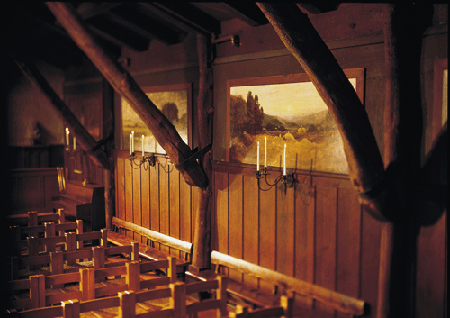
Photographs of the Swedenborgian Church by Jim Karageorge
ICONS | LESLIE M. FREUDENHEIM
From 1876 to 1910, a group of creative and pioneering men and women in Northern California sought an architectural expression appropriate to the region. They rejected Victorian excess, preferring simple homes of natural materials. Their aspirations went beyond architecture to advocate a sensibility and a way of life.
The cradle of the movement was the Swedenborgian Church at Washington and Lyon Streets. Its leader was the modest but charistmatic Swedenborgian minister, Joseph Worcester, a serious student of architecture who inspired a quiet revolution as he turned Californians, and eventually Americans, toward the ideals of the Arts & Crafts movement and a return to a simpler life in harmony with nature.

First Mission-style chair created here
In 1894, A. J. Forbes began making the chairs for the Swedenborgian Church. The simple maple chairs, handmade without nails, with rush seats and flared feet, were the prototype for all Mission style furniture that would follow, including the well-known designs of Gustav Stickley and many others.
In a proposal dated November 1, 1894, Forbes offered to make the chairs and their rush seats for $4.50 each. Swedenborgian minister Joseph Worcester had fixed his mind on old-fashioned seats woven of tule rush from the Sacramento delta. “I haven’t made a rush seat for 35 years,” Forbes said, “but I think I can remember how to make these and I will teach others.”
As with the design of the church itself, the chair appears to have been a collaborative effort.

Home of the first Arts & Crafts society
Approximately one month before the Mission style chairs were being made for the Swedenborgian Church, and while the building was under construction, the earliest American Arts & Crafts society was formed here.
In September 1894, six years after the English Arts and Crafts Exhibition Society gave its name to the movement, Rev. Joseph Worcester’s friends established the Guild of Arts and Crafts of San Francisco. Arts & Crafts groups in Boston and Chicago would not hold their first meetings until three years later.
The San Francisco guild survived for only a few years, dying sometime after April 1897 as a result of squabbling among its members. But it had been publicized to a wide audience in California and beyond, reaching many who became sympathetic to the ideas and style of the Arts & Crafts movement.
MORE: “Still teaching its lessons“
Filed under: Art & Design, Landmarks




